
The artist I am looking at today is George Hendrik Breitner, the nineteenth century Dutch painter, who was best known for his realistic depiction of Amsterdam street and harbour scenes. He was also of great importance in what was later termed Amsterdam Impressionism.
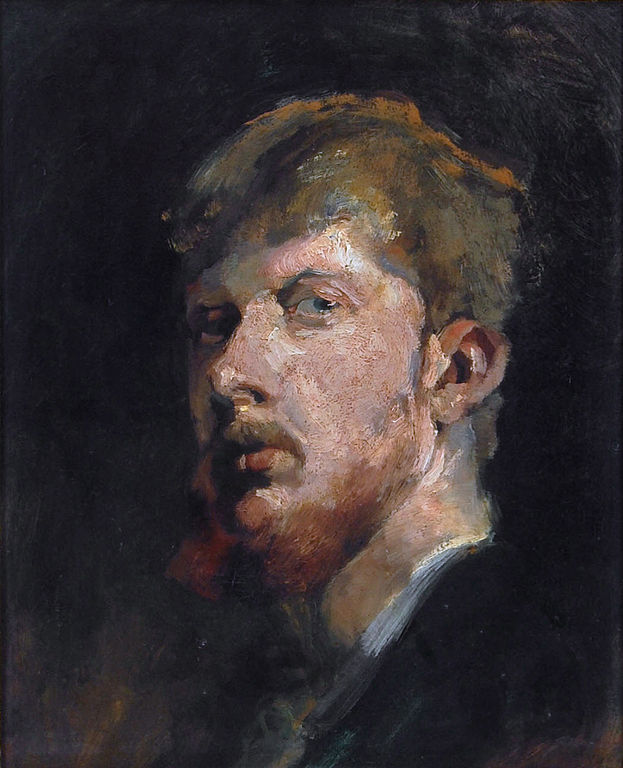
George Hendrik Breitner was born in Rotterdam on September 12th, 1857. He and his younger brother, Godfridus, were the children of Johan Wilhelm Heinrich Breitner and Marie Anne Henriette Gortmans. His father worked in the grain business and George, after finishing primary school, joined the Palthe & Haentjes, grain company, as a clerk. At the age of seventeen George went to the Delft Polytechnic School for vocational training. George showed a great talent for drawing and in January 1876, aged eighteen, partly because of the intercession of the artist Charles Rochussen, his father agreed to have him enrolled on a four-year course at the Koninklijke Academie van Beeldende Kunsten (Royal Academy of Art) in The Hague. He was an exemplary student and won a number of awards including a second prize for composition and two years later took the first prize in a live model competition. In October 1877 he obtained his teaching certificate and during 1878 and 1879 he taught art at the Leiden Art Society (Ars Aemula Naturae), originally the Leiden Guild of St. Luke.

In 1880 Breitner was expelled from the Art Academy for misconduct, his misdemeanour said to have been that he had destroyed the regulations-board. Around that time, he shared lodgings of the Dutch landscape painter of the Hague School, Willem Marisat, at the Oud Rozenburg house in The Hague. Marisat became Breitner’s friend and tutor. It was through Marisat that Breitner was accepted as a member of the Pulchri Studio, an important artist’s society in that city.

It was here that he met fellow member Hendrik Mesdag, a one-time banker but later an accomplished artist, whose forte was his maritime paintings, one of which, Les Brisants de la Mere du Nord (The Breakers of the North Sea), gained him the gold medal at the 1870 Paris Salon. In 1880, Mesdag had been commissioned by a group of Belgian entrepreneurs to paint a panorama depicting a view over the village of Scheveningen which lay on the North Sea coast close to The Hague. It was such a large project that Mesdag put together a team of artists including his wife Sientje, Theophile de Bock, Barend Blommers and twenty-three-year-old George Hendrik Breitner. The finished work which measured 14 metres high and 120 metres around, was completed in 1881 and I talked about in my My Daly Art Display blog

In 1882, Breitner made the acquaintance of another distinguished artist, Vincent van Gogh, and the two would often go on sketching trips around the poorer and seamier side of The Hague. In a letter to his brother Theo in February 1882, Vincent wrote:
“…. At the moment I quite often go to draw with Breitner, a young painter who’s acquainted with Rochussen as I am with Mauve. He draws very skilfully and very differently from me, and we often draw types together in the soup kitchen or the waiting room &c…”

For Breitner his models were the poorer working-class folk such as labourers and servant girls who plied their trade in the lower working-class areas of the city. Breitner preferred these working-class models such as labourers, servant girls and people from the lower-class districts. Interest in the fate of the common people, which many artists felt in that period, was cultivated by the social conscience of French writers such as Émile Zola and the realism paintings of Gustave Courbet and Jean-François Millet. Breitner believed that through his paintings he would create history. His desire to become famous for his realistic paintings of the poor can be seen in his letter he sent to his patron, the grain merchant, Adriaan Pieter van Stolk, dated March 28th 1882. Breitner wrote:
“…Myself, I will paint the people on the street and in the houses, they built, life above all, I’ll try to be Le peintre du peuple or I’ll be better because I want to be. History I wanted to paint and I will too, but history in its most extensive sense. A market, a quay, a river, a gang of soldiers under a glowing sun or in the snow…”.
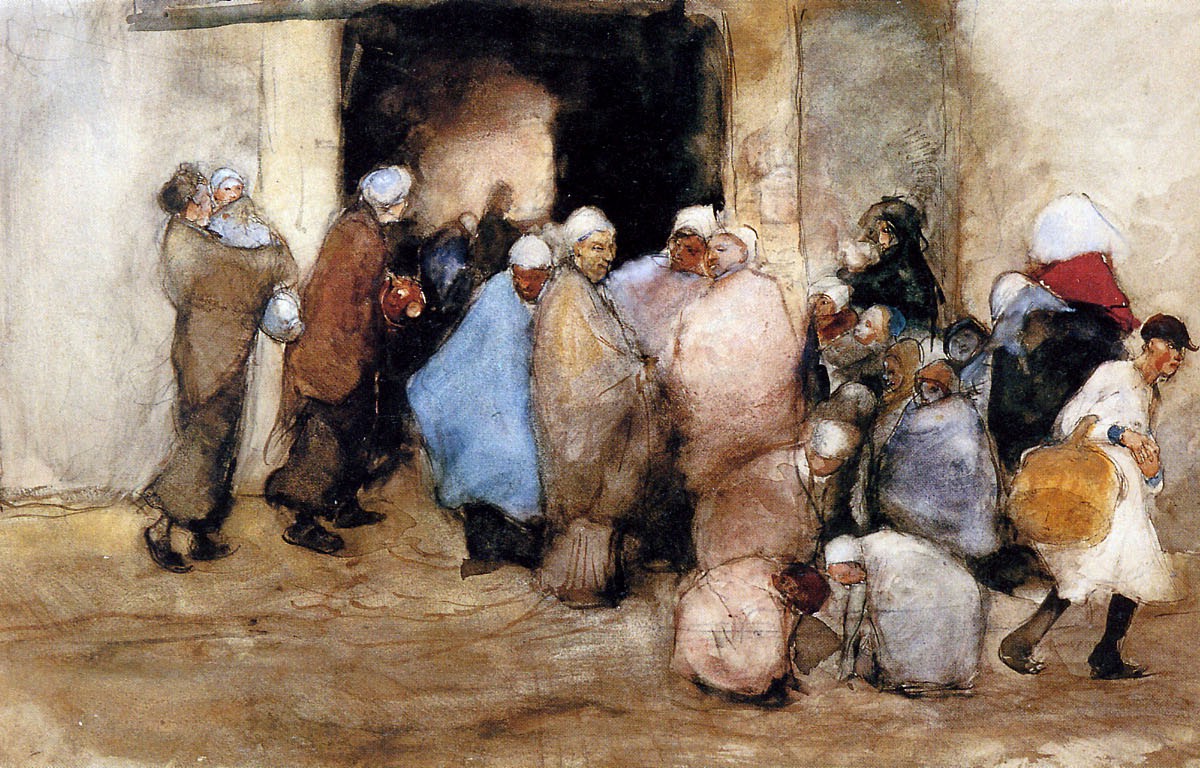
In May 1884 Breitner left The Hague and travelled to Paris. His stay in the French capital lasted only six months during which time he attended Atelier Cormon where he liked to depict the toiling workhorses or demolition scenes, using dark tones . He completed a number of paintings featuring the streets of the city with its horse and cart transportation. His desire to paint scenes of everyday life in the French capital was enhanced by his interest in and inspiration from the writings of Zola, Flaubert and especially Edmund and Jules de Goncourts with their book, Manette Salomon, being a favourite of Breitner.

Lennepkade, Amsterdam by George Breitner (1900)
In the late 1880’s, Breitner’s new hometown, Amsterdam, was beginning to expand, new industries were shooting up and it was pulsating with life. Breitner was afforded the ideal opportunity to record pictorially the changes. Now living in the city, he took the opportunity to hone his artistic talents by enrolling for a short period at the Royal Academy of Fine Arts under the tutelage of August Allebé, an exponent of realism and impressionism. Breitner’s cityscape paintings of that era, although maybe not topographically accurate, were emotional depictions, full of colour and movement. His depiction of the common people was somewhat different as he used greys and browns to portray the hard and laborious tasks, they had to perform to earn a meagre wage. His paintings were often both emotional and sensitive.
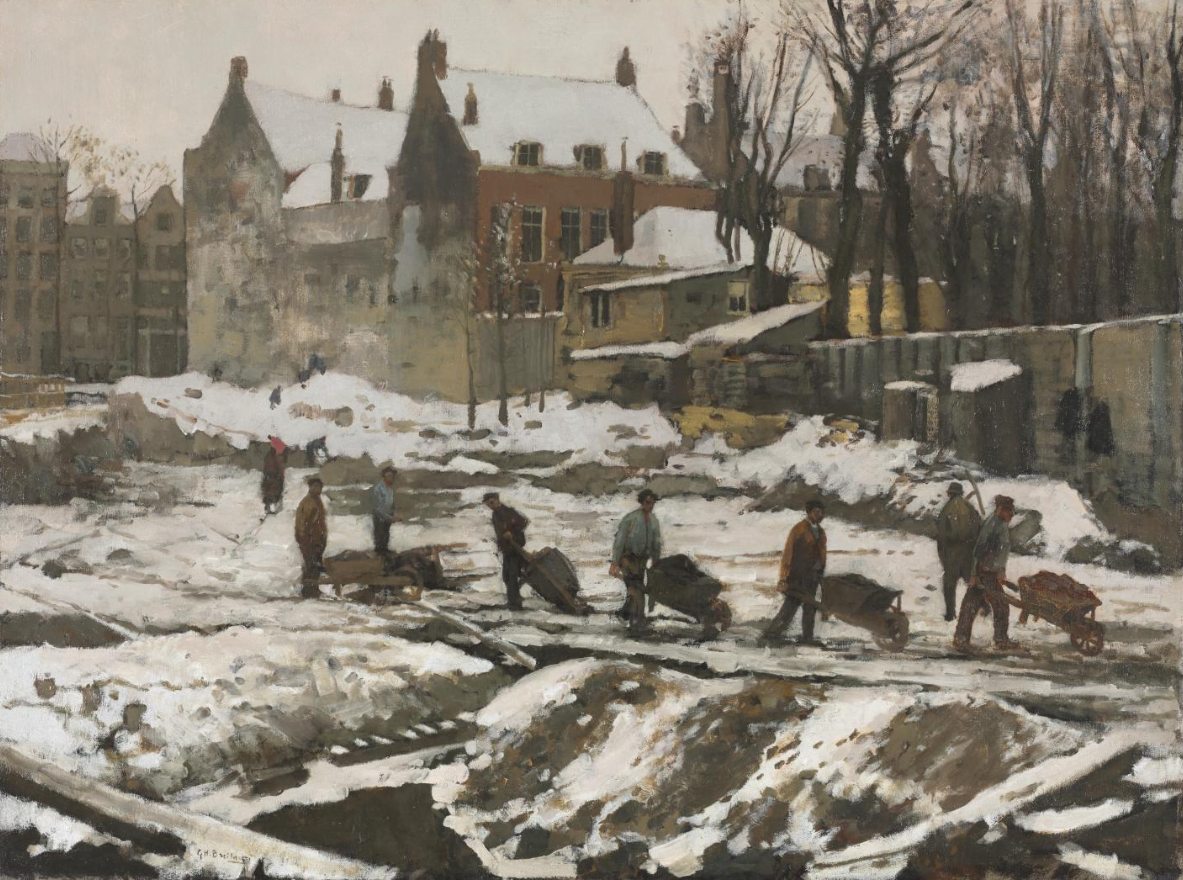
Breitner’s 1902 painting, Construction Site in Amsterdam, highlights the building boom in Amsterdam. He based the painting on a series of photographs he took of a construction site in the city. Although it may have been thought to be an en plein air work, the painting was in fact carefully created in his Prinseneiland studio. Through the use of his photographs and sketches, he was able to portray an ever-changing city.
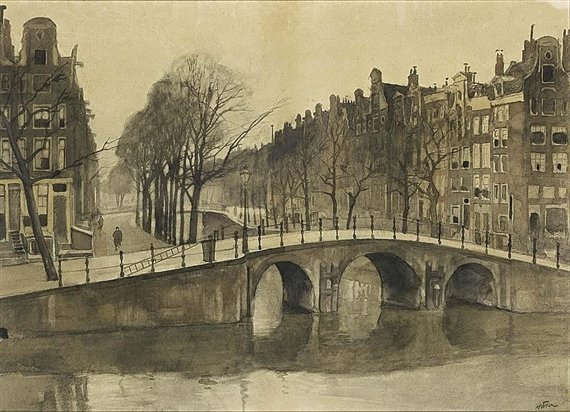
One of the painters he liked at this time and whose work influenced him was the Dutch painter and photographer associated with the Amsterdam Impressionism movement, Willem Witsen, whose best works include serene views of Amsterdam, such as his depictions of the canal areas Herengracht and Leidsegracht.

In the late 1880’s, beside his cityscape works, Breitner embarked on painting nudes.

In 1893, he completed a series of paintings featuring Japanese girls, a beloved theme of many painters in those days. Japonism, which referred to the French term, japonisme, which denotes the assimilation of iconography or concepts of Japanese art into European art and design. Most of the Impressionists and Neo-Impressionists painters were influenced by this phenomenon.

Breitner was Inspired by Japanese prints he had seen between 1893 and 1896 and completed thirteen paintings featuring a girl in a kimono. In each the young woman assumes different positions and the kimono often are of different colours. In the above 1894 work, Girl in a White Kimono, what stands out the most in the depiction is the exquisitely embroidered, white silk kimono with red-trimmed sleeves and an orange sash. For this painting and many in the series, Breitner utilised the services of seventeen-year-old Geesje Kwak, a seamstress who was also one of his regular models.

In his earlier days during his time in The Hague, Breitner had been criticised in the media for his drawings and his attempts at Impressionism and even his patron had pressed him just to paint what the public wanted. Breitner baulked at this advice and his relationship with van Stolk ended. In the late 1880’s, then living in Amsterdam, there was a change in his fortune and with every passing month, he gained more and more recognition as a talented artist. In 1886 Breitner completed one of his great masterpieces, De Gele Ruiters (The Yellow Riders). It was a monumental work measuring 115 x 76 cms and featured the elite mounted artillery corps seen galloping down the sand dunes at breakneck speed. Breitner took full advantage of their black-and-red busbies and the gold braid on their uniforms, which adds to the vitality of the charge.

We witness the sand being kicked up by the hooves of the horses at the front which clouds our view of the horsemen who follow and all we can make out of them are the flashes of black, yellow and red of the following troops. In the October 16th 1886 edition of the Netherlands Spectator, the Dutch poet and art critic, Carel Vosmaer, wrote
“…But what a momentum and storm in the movement, what a feeling for the poetry of such a tingling, dusty, turbulent group!..”
In the same year Breitner was invited by the avant-garde Société des XX (Vingtistes) to show his work in Brussels. More and more was written in the press about him and his work. At the turn of the century, George Breitner was forty-two-years-old and at the high point in his artistic career. So, what was he like as a person ? In his biography of the artist, Breitner, by Arthur van Schendel, he quoted the description of the artist by people who knew him, writing:
“…often fierce and brusque in his performance, sometimes suddenly rigid and closed, living among bouts of passion and despondency and always possessed wholeheartedly for his art…”
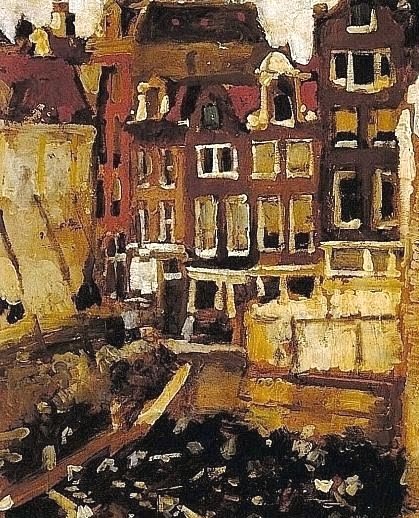
In 1901 an exhibition of his work was held, a highly successful retrospective at Amsterdam’s Arti et Amicitiae, one of the largest clubs for artists and art lovers in the Netherlands. At this time Breitner would use his photographs as a preparation for a painting. He built up a collection of people and cityscapes form a historical document of life in the city of Amsterdam at the end of the 19th century and it was these which helped to document city life at the turn of the century. These photographs and his cityscapes often appeared in historical publications.
On September 18th, that same year, 1901, George Hendrik Breitner married Maria Catharina Josephina Jordan in Amsterdam. His wife was nine years younger than him. The couple had no children.
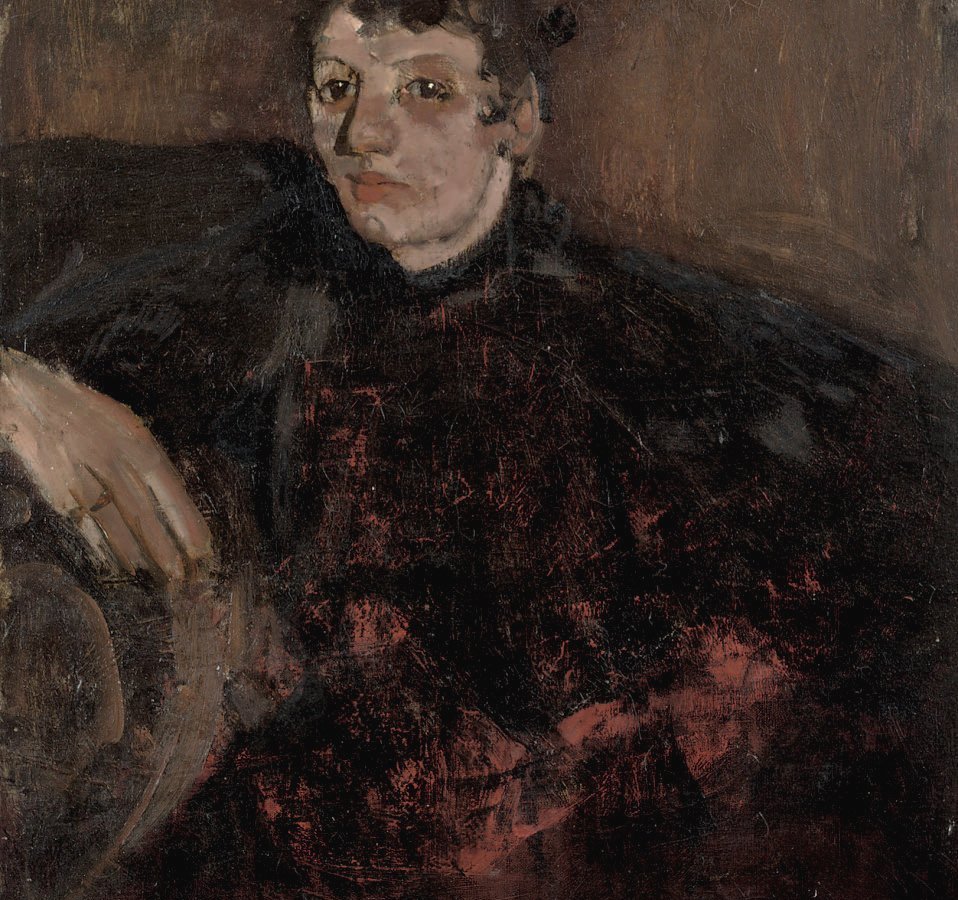
Breitner painted a portrait of his wife, which, in my eyes, seems less than flattering.

A more flattering portrait was done by Breitner’s friend Willem Witsen.

Witsen also completed a portrait of George Breitner.
In 1903 Breitner decided to move away from Amsterdam and relocate to Aerdenhout, a small town located in the dunes between Haarlem and the seaside town of Zandvoort, some twelve miles west of Amsterdam. His decision to move away from the city was because his friend and fellow artist, Marius Bauer, had moved there and wanted Breitner to join him. However, Breitner missed Amsterdam and in 1906 he returned to the city.

In 1904 Breitner completed his work entitled Rokin with the Nieuwezijdskapel, Amsterdam. The Rokin is a canal and major street in the centre of Amsterdam and is a recurring theme in Breitner’s works. Breitner would spend much time in this area, sketching and photographing people and buildings. The art gallery Van Wisselingh & Co. was found in this area as was his artist’s society Arti et Amicitiae which can be seen in the background. The painting fetched 415,200 euros at Christie’s Amsterdam auction in April 2005.
Although Breitner was successful as an artist and enjoyed a great reputation during his life, he did encounter financial difficulties during his life and this led to the establishment of a support committee for him and his wife. On June 5, 1923, George Hendrik Breitner died of a heart attack, aged 65. George Breitner is seen as one of the most important painters in the Netherlands at the end of the 19th century – but internationally he is less well known as an artist.

As always, a wonderful article bringing the artist’s work the attention he deserves. Thank you:)